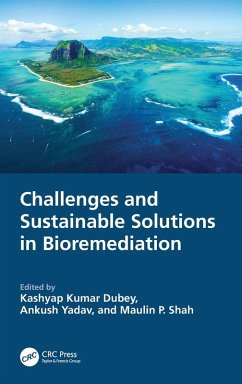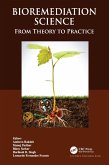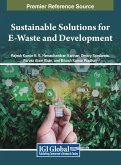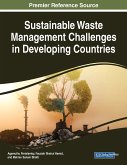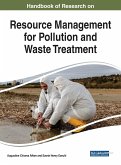Challenges and Sustainable Solutions in Bioremediation
Herausgeber: Dubey, Kashyap Kumar; Yadav, Ankush; Shah, Maulin P.
Challenges and Sustainable Solutions in Bioremediation
Herausgeber: Dubey, Kashyap Kumar; Yadav, Ankush; Shah, Maulin P.
- Gebundenes Buch
- Merkliste
- Auf die Merkliste
- Bewerten Bewerten
- Teilen
- Produkt teilen
- Produkterinnerung
- Produkterinnerung
This book highlights the characteristics, aims, and applications of microorganisms as a crucial solution for sustainable management of the toxic pollutants in ecosystem/aquatic ecosystems, soil and air.
Andere Kunden interessierten sich auch für
![Designer Biochar Assisted Bioremediation of Industrial Effluents Designer Biochar Assisted Bioremediation of Industrial Effluents]() Designer Biochar Assisted Bioremediation of Industrial Effluents148,99 €
Designer Biochar Assisted Bioremediation of Industrial Effluents148,99 €![Bioremediation Science Bioremediation Science]() Bioremediation Science236,99 €
Bioremediation Science236,99 €![Development Challenges and Solutions After the Arab Spring Development Challenges and Solutions After the Arab Spring]() Development Challenges and Solutions After the Arab Spring38,99 €
Development Challenges and Solutions After the Arab Spring38,99 €![Rising Tides, Rising Solutions Rising Tides, Rising Solutions]() Alexandra GreenfieldRising Tides, Rising Solutions20,99 €
Alexandra GreenfieldRising Tides, Rising Solutions20,99 €![Sustainable Solutions for E-Waste and Development Sustainable Solutions for E-Waste and Development]() Sustainable Solutions for E-Waste and Development242,99 €
Sustainable Solutions for E-Waste and Development242,99 €![Sustainable Waste Management Challenges in Developing Countries Sustainable Waste Management Challenges in Developing Countries]() Sustainable Waste Management Challenges in Developing Countries174,99 €
Sustainable Waste Management Challenges in Developing Countries174,99 €![Handbook of Research on Resource Management for Pollution and Waste Treatment Handbook of Research on Resource Management for Pollution and Waste Treatment]() Handbook of Research on Resource Management for Pollution and Waste Treatment296,99 €
Handbook of Research on Resource Management for Pollution and Waste Treatment296,99 €-
-
-
This book highlights the characteristics, aims, and applications of microorganisms as a crucial solution for sustainable management of the toxic pollutants in ecosystem/aquatic ecosystems, soil and air.
Produktdetails
- Produktdetails
- Verlag: CRC Press
- Seitenzahl: 204
- Erscheinungstermin: 24. Februar 2025
- Englisch
- Abmessung: 240mm x 161mm x 16mm
- Gewicht: 476g
- ISBN-13: 9781032525815
- ISBN-10: 1032525819
- Artikelnr.: 71628450
- Herstellerkennzeichnung
- Libri GmbH
- Europaallee 1
- 36244 Bad Hersfeld
- gpsr@libri.de
- Verlag: CRC Press
- Seitenzahl: 204
- Erscheinungstermin: 24. Februar 2025
- Englisch
- Abmessung: 240mm x 161mm x 16mm
- Gewicht: 476g
- ISBN-13: 9781032525815
- ISBN-10: 1032525819
- Artikelnr.: 71628450
- Herstellerkennzeichnung
- Libri GmbH
- Europaallee 1
- 36244 Bad Hersfeld
- gpsr@libri.de
Prof. Kashyap Kumar Dubey is currently working as DEAN at the School of Biotechnology, JNU, New Delhi. His research interests are in biochemical engineering and wastewater treatment that includes process development of value-added pharmaceutical products through optimization of enzyme reactions and toxicological studies of micro-pollutants. Dr. Ankush Yadav is currently working as Assistant Professor in the Department of Botany, Zakir Husain Delhi College, University of Delhi, New Delhi. His research interests are in wastewater treatment that includes the identification of hazardous emerging contaminants from wastewater; their toxicity analysis; and process development for bioremediation of emerging hazardous pharmaceuticals or biomedical waste from the aquatic environment. Dr. Maulin P Shah is an active researcher and scientific writer in his field for over 20 years. His research interests include biological wastewater treatment, environmental microbiology, biodegradation, bioremediation, and phytoremediation of environmental pollutants from industrial wastewaters. He has published more than 240 research papers in national and international journals of repute on various aspects of microbial biodegradation and bioremediation of environmental pollutants. He is the editor of 65 books of international repute.
Chapter 1 Recent Technologies and Strategies for Bioremediation of Toxic
and Hazardous Waste; Chapter 2 Microbial Biofilms: Revolutionizing
Fermentation and Bioremediation of Environmental Pollutants; Chapter 3
Microbial Strategies of Chrysene Remediation; Chapter 4 Environmental
Remediation of Noxious Agrochemicals Using Engineered Materials of
Bio-Origin; Chapter 5 Biochemical and Molecular Aspects of Phytoremediation
toward Mitigation of Heavy Metals; Chapter 6 Computational Modelling in
Bioremediation: Innovations and Future Directions; Chapter 7 Navigating
Nanomaterials: A Path to Sustainable Wastewater Treatment; Chapter 8
Challenges and Sustainable Solution for the Detection and Bioremediation of
Microplastic Pollution: Challenges and Scope of Their Remediation From the
Environment; Chapter 9 Challenges in Bioremediation: Overcoming
Environmental and Technological Barriers; Chapter 10 Bioremediation
Strategies for Petroleum Hydrocarbons, Heavy Metals, and Pesticides
and Hazardous Waste; Chapter 2 Microbial Biofilms: Revolutionizing
Fermentation and Bioremediation of Environmental Pollutants; Chapter 3
Microbial Strategies of Chrysene Remediation; Chapter 4 Environmental
Remediation of Noxious Agrochemicals Using Engineered Materials of
Bio-Origin; Chapter 5 Biochemical and Molecular Aspects of Phytoremediation
toward Mitigation of Heavy Metals; Chapter 6 Computational Modelling in
Bioremediation: Innovations and Future Directions; Chapter 7 Navigating
Nanomaterials: A Path to Sustainable Wastewater Treatment; Chapter 8
Challenges and Sustainable Solution for the Detection and Bioremediation of
Microplastic Pollution: Challenges and Scope of Their Remediation From the
Environment; Chapter 9 Challenges in Bioremediation: Overcoming
Environmental and Technological Barriers; Chapter 10 Bioremediation
Strategies for Petroleum Hydrocarbons, Heavy Metals, and Pesticides
Chapter 1 Recent Technologies and Strategies for Bioremediation of Toxic
and Hazardous Waste; Chapter 2 Microbial Biofilms: Revolutionizing
Fermentation and Bioremediation of Environmental Pollutants; Chapter 3
Microbial Strategies of Chrysene Remediation; Chapter 4 Environmental
Remediation of Noxious Agrochemicals Using Engineered Materials of
Bio-Origin; Chapter 5 Biochemical and Molecular Aspects of Phytoremediation
toward Mitigation of Heavy Metals; Chapter 6 Computational Modelling in
Bioremediation: Innovations and Future Directions; Chapter 7 Navigating
Nanomaterials: A Path to Sustainable Wastewater Treatment; Chapter 8
Challenges and Sustainable Solution for the Detection and Bioremediation of
Microplastic Pollution: Challenges and Scope of Their Remediation From the
Environment; Chapter 9 Challenges in Bioremediation: Overcoming
Environmental and Technological Barriers; Chapter 10 Bioremediation
Strategies for Petroleum Hydrocarbons, Heavy Metals, and Pesticides
and Hazardous Waste; Chapter 2 Microbial Biofilms: Revolutionizing
Fermentation and Bioremediation of Environmental Pollutants; Chapter 3
Microbial Strategies of Chrysene Remediation; Chapter 4 Environmental
Remediation of Noxious Agrochemicals Using Engineered Materials of
Bio-Origin; Chapter 5 Biochemical and Molecular Aspects of Phytoremediation
toward Mitigation of Heavy Metals; Chapter 6 Computational Modelling in
Bioremediation: Innovations and Future Directions; Chapter 7 Navigating
Nanomaterials: A Path to Sustainable Wastewater Treatment; Chapter 8
Challenges and Sustainable Solution for the Detection and Bioremediation of
Microplastic Pollution: Challenges and Scope of Their Remediation From the
Environment; Chapter 9 Challenges in Bioremediation: Overcoming
Environmental and Technological Barriers; Chapter 10 Bioremediation
Strategies for Petroleum Hydrocarbons, Heavy Metals, and Pesticides

